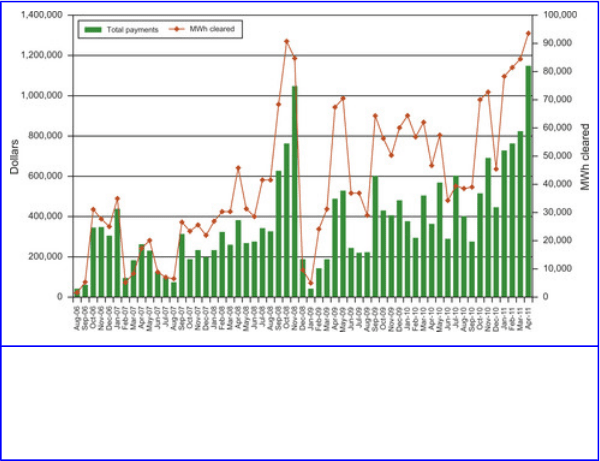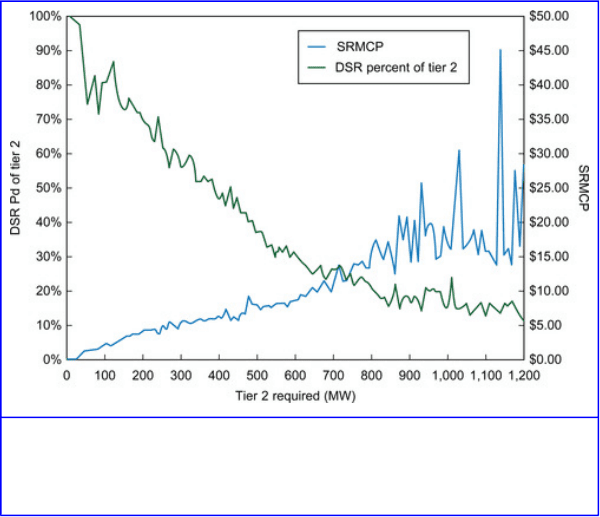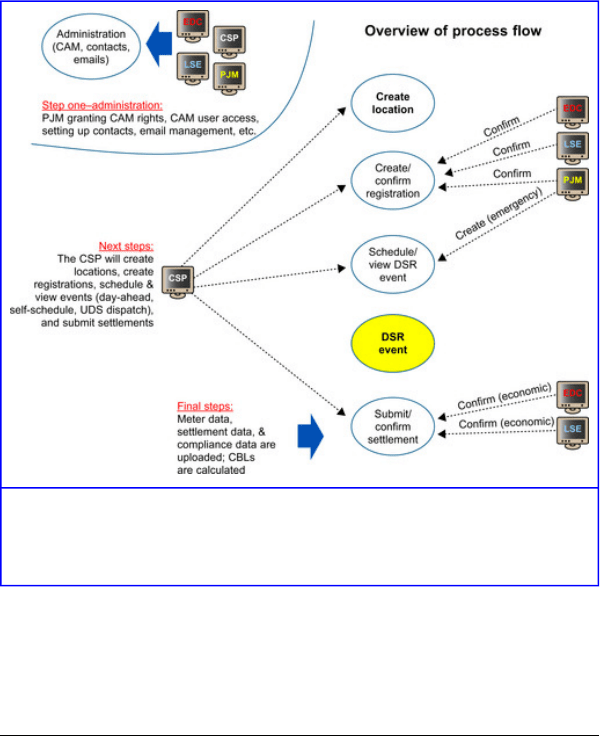Sioshansi F.P. Smart Grid: Integrating Renewable, Distributed & Efficient Energy
Подождите немного. Документ загружается.

does not require telemetry for DR participation in the
Synchronized Reserve Market, relying instead on the
one-minute meter data discussed above, submitted within 24
hours of the event. This single difference significantly affects
the cost of market participation for DR and partially accounts
for the continued growth of DR Synchronized Reserve
Market participation.
31
PJM Interconnection, L.L.C., Initial Filing, Docket No. ER06-406-000
(December 28, 2005) and PJM Interconnection, L.L.C., 114 FERC
¶61,201 (2006).
It should be emphasized that DR need not make a demand
reduction until a Synchronized Reserve Event is called, but
must be ready to do so on short notice. The metering
information must be uploaded to PJM's Load Response
application (eLRS) within one business day of the event to
ensure compliance. The overall participation by DR currently
is limited to 25% of the SR requirement in each SR Zone
while PJM gains experience with DR participation in this
market. To ensure that proper reliability standards are
maintained, there are mandatory training requirements for
CSPs that desire to bid load reduction capability in the SR
Market.
The SR Market also accommodates the participation by
industrial sites engaged in “batch load” manufacturing
processes. Batch load manufacturing processes include arc
furnaces that make steel, which typically draw no power at all
for the 10-minute periods between melts. Should PJM call for
synchronized reserve during the no-load phase of the process,
then it would be impossible for the one-minute metering
readings to demonstrate compliance. PJM market rules
851

accommodate “batch loads” that are already down when the
event begins by comparing the meter reading at the beginning
of the event, which should be zero, with the meter reading 10
minutes after the event ends when the usage should have
increased by at least the amount of MW cleared in the
Synchronized Reserve Market.
The SR Market is cleared every hour based on the offers that
are submitted by various resources. The minimum size of a
DR offer is 500 kw or .5 MW. The CSP may aggregate DR to
achieve the 500-kw minimum requirement.
32
The
market-clearing results establish the SR assignments for each
cleared resource in order to meet the SR requirement for each
SR zone. Each assigned resource is paid the SR clearing price
for providing the service for the hour. Should a DR or
generation resource fail to respond to a Synchronized Reserve
Event, the penalty imposed is the supply of SR during the
same time period in which the resource failed to respond to
the call for SR.
32
Originally the minimum size was 1 MW and aggregation could not be
done, but this was changed by FERC Order 719. See Wholesale
Competition in Regions with Organized Electric Markets, Order No.
719, FERC Stats. & Regs. ¶31,281 (2008) and PJM Interconnection,
L.L.C., Initial Filing, Docket No. ER09-701-000 (February 9, 2009).
Regulation Market
Regulation service provides for the continuous balancing of
generation, load, and interchange at a very granular level.
Specifically Regulation maintains system frequency at 60
cycles per second (HZ). Regulation is accomplished through
the raising or lowering of output by Generation Capacity
852

Resources or the raising or lowering of loads by DR
Resources as required. CSPs that offer DR into the Regulation
Market must meet all the criteria necessary to provide
Regulation in the PJM Manuals including the ability to
receive Automatic Generation Control (AGC) signals and
must have the appropriate telemetry to the PJM Control
Center. As with synchronized reserve, the CSP must be able
to aggregate a minimum of 500 kw or .5 MW of qualified
load reduction capability to offer a DR resource into the
Regulation Market. Current market rules also limit DR to
25% of the Regulation requirement in the RFC region. There
are, as with DR participation in the Synchronized Reserve
Market, mandatory training requirements for CSPs that desire
to offer load reduction capability in the Regulation Market.
To date no DR resources have participated in the PJM
Regulation Market.
Potential Financial Benefits and Market Results
The ability for a Demand Resource to reduce overall
expenditures through participation in the SR Market can be
significant. For example, if a 1-MW DR supplied SR in the
Mid-Atlantic sub-zone of the Reliability First Corporation
(RFC) area in all hours during 2007, that resource would have
been paid $63,522 that could have offset its energy and
capacity expenditures. In 2008 the same DR would have been
paid $45,971.
While market rules provide for energy payments related to
load reductions achieved in response to a synchronized
reserve event, CSPs have not submitted settlements for
associated energy payments. Given the infrequency and short
duration of synchronized reserve events, the preparation and
853

submittal of an energy settlement for load reduction during a
synchronized reserve event are not worthwhile. The incentive
for the CSP to participate in the Synchronized Reserve
Market comes from the revenue associated with clearing in
that market and being ready, willing, and able to reduce load
within 10 minutes for a 30-minute period during a
synchronized reserve event.
Figure 17.11 shows the additional revenue stream paid to
CSPs for the growing number DR resources qualified to
provide SR from August 2006 through March 2011. The first
qualified DR resource participated in the SR Market on
August 17, 2006. The trend in market participation by DR has
been increasing and the revenues earned by DR providing
Synchronized Reserve have also been steadily increasing.
Figure 17.11
DR participation in the Synchronized Reserve Market.
Source: PJM
854
To date no DR resources have offered into or cleared the
Regulation Market. A few DR resources, however, have
proved their capability to provide regulation service in the
context of Alternative Technology Pilots initiated by PJM in
2010. The financial rewards of DR participation in the
Regulation Market have the potential to exceed revenue
streams available in the Synchronized Reserve Market.
During 2007, for example, 1 MW of DR, provided as
regulation service during hours when the clearing price
equaled or exceeded $100/MWh, would have resulted in total
compensation of $50,939 for providing regulation in 337 of
the 8,760 total annual operating hours (3.8% of all hours).
Moreover, the participation of DR in the Ancillary Service
Market adds competition that drives down the cost of these
services for all market participants, increases market
efficiency, reserves valuable generation resources for the
production of electricity, and reduces the wear and tear of
constant ramping, particularly on steam units. For example,
the PJM Independent Market Monitor has shown that greater
the DR participation in the SR Market, tends to lower the
market-clearing price. Figure 17.12 shows clearly the greater
the DR participation shown in green, the lower is the market
prices shown in blue.
33
2010 State of the Market Report, Figure 6-12, p. 459.
855

Figure 17.12
DR and SR market prices.
33
Administration of DR in PJM's Markets
PJM completed important system enhancements for DR
participation in mid-2009. Enhancements to PJM's eMarket
system
34
streamlined DR participation in the Energy Market
and are known as the eLRS application.
35
eLRS went into
production at the beginning of July 2009 following a massive
movement of data from the old system. PJM uses the eLRS
application to process registrations and settlements for DR,
including the calculation of the CBLs used for settlement
payments to CSPs. PJM works with CSPs as well as EDCs
and LSEs on an ongoing basis to plan, prioritize, and
implement eLRS enhancements. eLRS is an xml, IP protocol,
web-enabled application that manages DR participation in
856
PJMs markets for approximately 60 CSPs and well over
10,000 end-use sites.
34
The eMarket system is the software application used by market
participants to provide PJM with the offer curve for each resource
participating in the Energy Market. PJM uses the pricing information in
eMarket to schedule and dispatch offered resources.
35
The eLRS application is the software application that allows market
participants and PJM to adminster DR participation in the markets. The
eLRS application administers registrations, notifications of
self-scheduled Economic Load Response, and settlements for demand
response resources.
During 2010 eLRS handled over 21,000 site-hours of
dispatched Real-Time Energy Market notifications of
reductions from over 800 sites and over 71,000 site-hours of
self-scheduled notifications of load reductions in the
Real-Time Energy Market from over 800 sites. Figure 17.13
shows the data and process workflow handled by eLRS from
the creation of registrations, the submission of notifications,
and schedules, all the way through to calculation of the CBL
and to settlements for load reductions.
857

Figure 17.13
Flow of information in administering DR in PJM's markets.
DR Participation Going Forward: Current Issues
Related to Demand Response
Price-Responsive Demand
As is being discussed in the PJM stakeholder process, DR is
contemplated to evolve into what is being called
price-responsive demand (PRD), which accounts for the load
reduction activity of DR on the demand side of the market
rather than as a supply resource, which is the current
paradigm.
36
PRD is not meant to replace DR participation as
it currently exists, but is envisioned as providing yet another
858

option for participants on the demand side of PJM's markets
that will better integrate the wholesale and retail markets
without infringing on the jurisdictional authority of the states
and others over the retail side of the market.
36
See PRD under PJM's Issue Tracking feature on its website at
www.pjm.com/committees-and-groups/issue-tracking/
issue-tracking-details.aspx?Issue=%BCD79A76A-E9E4-4F58-ADF9-88A65F2B61EB%
Although PRD is the next generation of demand-side
participation, DR participation in its current form has become
a fixed and necessary piece of PJM's markets. Out of
necessity or as a natural evolution of DR participation, there
are refinements that are currently under consideration and
issues that continually arise that may alter how DR
participates in PJM's markets. These range from refinements
to calculating customer baselines for settlements in the PJM
Energy Market to defining additional DR capacity products
based on the ability to respond more frequently in more
seasons of the year to the compensation paid to DR in the
PJM Energy Market.
Customer Baseline Calculation Revisited
Among the issues addressed by the Load Management Task
Force in 2010 was the need for greater clarity in measuring
and verifying compliance by DR that commits to reduce load
by a prescribed amount during an Emergency Event. Unlike
either Firm Service Level or Direct Load Control, measuring
the compliance of Guaranteed Load Drop Load Management
requires a CBL. While the rules clearly require use of the
methodology that will produce the most accurate
measurement of the CBL and the resulting achieved load
859
reduction, the CSP must choose from among several
methodologies, including Comparable Day, Same Day,
Economic CBL, Load Profile, or Regression Analysis. The
lack of precise rules for using some of these methodologies
led many CSPs to question how to apply some of the
methodologies and raised concerns by PJM staff, the Market
Monitoring Unit (MMU), and other PJM stakeholders about
the integrity of GLD measurement and compliance.
Late in 2010 following a report from the Load Management
Task Force, the Market Implementation Committee directed
PJM to once again undertake a comprehensive study and
evaluation of alternative customer baseline calculations. PJM
staff also consulted other organized wholesale electricity
markets before settling on 18 different baseline calculations
for study and evaluation. KEMA, the consultant retained by
PJM to perform the study, used actual, annual meter data
from a variety of customers that do not participate as DR to
evaluate each of the 18 identified CBL calculations. The
results were compared based on accuracy, bias, simplicity,
and cost.
37
PRD, being on the demand side of the market and
not treated as a supply resource, does not face the same kind
of CBL controversy, and PRD's performance is based on how
much it consumes alone, rather than how much it consumes
relative to a baseline.
37
Hennessy, Tim and Langbein, Pete, “PJM Empirical Analysis of
Demand Response Baseline Methods Results,” PJM Markets
Implementation Committee, May 10, 2011. http://www.pjm.com/~/
media/committees-groups/committees/mic/20110510/
20110510-item-09-cbl-analysis.ashx See also “PJM Empirical Analysis
of Demand Response Baseline Methods,” prepared by KEMA, Inc.,
April 20, 2011. http://www.pjm.com/~/media/committees-groups/
committees/mic/20110510/20110510-item-09a-cbl-analysis-report.ashx.
860
